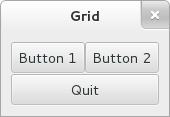When creating an application, you'll want to put more than one widget inside a window. When you want to put more than one widget into a window, it becomes important to control how each widget is positioned and sized. This is where packing comes in.
GTK+ comes with a large variety of layout containers whose purpose it is to control the layout of the child widgets that are added to them. See Layout Containers for an overview.
The following example shows how the GtkGrid container lets you arrange several buttons:

Example 2. Packing buttons
Create a new file with the following content named example-2.c.
#include <gtk/gtk.h>
static void
print_hello (GtkWidget *widget,
gpointer data)
{
g_print ("Hello World\n");
}
static void
activate (GtkApplication *app,
gpointer user_data)
{
GtkWidget *window;
GtkWidget *grid;
GtkWidget *button;
/* create a new window, and set its title */
window = gtk_application_window_new (app);
gtk_window_set_title (GTK_WINDOW (window), "Window");
gtk_container_set_border_width (GTK_CONTAINER (window), 10);
/* Here we construct the container that is going pack our buttons */
grid = gtk_grid_new ();
/* Pack the container in the window */
gtk_container_add (GTK_CONTAINER (window), grid);
button = gtk_button_new_with_label ("Button 1");
g_signal_connect (button, "clicked", G_CALLBACK (print_hello), NULL);
/* Place the first button in the grid cell (0, 0), and make it fill
* just 1 cell horizontally and vertically (ie no spanning)
*/
gtk_grid_attach (GTK_GRID (grid), button, 0, 0, 1, 1);
button = gtk_button_new_with_label ("Button 2");
g_signal_connect (button, "clicked", G_CALLBACK (print_hello), NULL);
/* Place the second button in the grid cell (1, 0), and make it fill
* just 1 cell horizontally and vertically (ie no spanning)
*/
gtk_grid_attach (GTK_GRID (grid), button, 1, 0, 1, 1);
button = gtk_button_new_with_label ("Quit");
g_signal_connect_swapped (button, "clicked", G_CALLBACK (gtk_widget_destroy), window);
/* Place the Quit button in the grid cell (0, 1), and make it
* span 2 columns.
*/
gtk_grid_attach (GTK_GRID (grid), button, 0, 1, 2, 1);
/* Now that we are done packing our widgets, we show them all
* in one go, by calling gtk_widget_show_all() on the window.
* This call recursively calls gtk_widget_show() on all widgets
* that are contained in the window, directly or indirectly.
*/
gtk_widget_show_all (window);
}
int
main (int argc,
char **argv)
{
GtkApplication *app;
int status;
app = gtk_application_new ("org.gtk.example", G_APPLICATION_FLAGS_NONE);
g_signal_connect (app, "activate", G_CALLBACK (activate), NULL);
status = g_application_run (G_APPLICATION (app), argc, argv);
g_object_unref (app);
return status;
}
You can compile the program above with GCC using:
gcc `pkg-config --cflags gtk+-3.0` -o example-2 example-2.c `pkg-config --libs gtk+-3.0`
